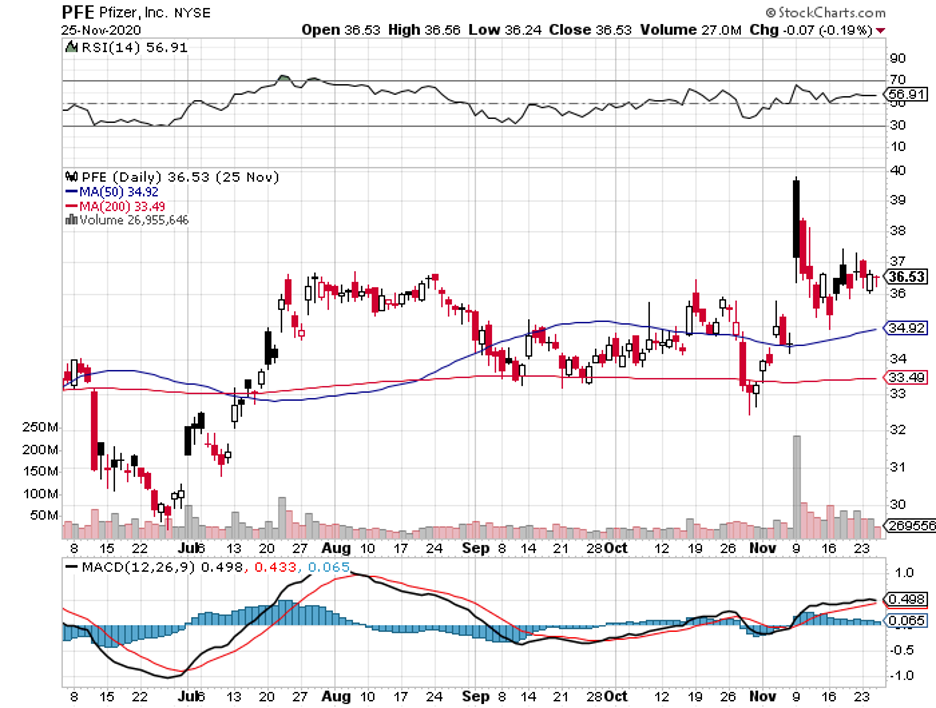In the history of corporate ventures, Pfizer (PFE) is one of the select few that can claim that their contributions genuinely contribute to the betterment of mankind.
This giant biopharmaceutical company has rapidly developed a promising vaccine candidate for the deadly COVID-19—an achievement that could potentially put an end to the global pandemic that has transformed 2020 into an apocalyptic year.
To date, Pfizer and its partner BioNTech (BNTX) have submitted the vaccine, BNT162b2, to the FDA for review—a move that could take us all a step closer to returning to our normal everyday lives, where we can be with our friends and loved ones without fretting over deadly infections.
If BNT162b2 gains approval, Pfizer and BioNTech can start the distribution by Christmas.
As expected, the COVID-19 vaccine will provide a quick and substantial boost to the company’s revenue this year.
Outside its COVID-19 program, Pfizer has a number of blockbuster treatments that have been generating steady growth despite the health and financial crises this year.
At the top of the list are breast cancer drug Ibrance and stroke and blood clot medication Eliquis. Other stars of Pfizer’s strong lineup include rheumatoid arthritis medication Xeljanz, heart failure treatment Vyndaqel, and prostate cancer drug Xtandi.
In terms of its pipeline, Pfizer has at least six programs queued for regulatory approval and an additional 21 candidates undergoing late-stage trials.
While Pfizer and BioNTech are leading the charge in the COVID-19 vaccine race, this is not necessarily a winner-take-all-market.
Days after Pfizer announced the results of its trials, fellow vaccine developer Moderna (MRNA) also released promising data. Another biotechnology company, Novavax (NVAX), has been sending out impressive results as well.
Even AstraZeneca (AZN), which has been working with Oxford, offered good news despite the delays in its own trials.
Meanwhile, Johnson & Johnson (JNJ) and Merck (MRK) have been making progress in their own COVID-19 programs as well.
However, there’s a crucial role played by Pfizer’s success.
It introduced to us the possibility of jumpstarting a vaccine program and shortening the development period that typically takes at least 10 to 15 years to complete.
More impressively, Pfizer has managed to come up with a vaccine with 95% efficacy – an amazing feat considering that 90% to 95% of vaccine trials tend to fail from the very beginning.
Most importantly, Pfizer’s recent results showed that we can now explore new options in vaccine development.
Taking BNT162b2 into consideration, this program opened doors for treatments created based directly on the molecular and even genetic structure of viruses.
Needless to say, Pfizer is a compelling stock to buy at a time when it is the norm to complain about having nothing to purchase at a reasonable price.
Additionally, Pfizer shares offer a dividend yield of 4.2% – a major advantage in a financial market that appears to be starved for any sort of security.
For those patient enough, the current conditions look to be ripe to use options to make the most of the short-term volatility to position yourselves for long-term gains.
By selling puts and buying calls, you can get the options market to pay them to purchase stock at cheaper prices and even participate in any rallies.
With Pfizer stock priced at around $36.18 these days, you can sell the January $36 put and buy the January $38 call for a credit of roughly 60 cents.
If Pfizer stock rallies, then you profit.
If the stock falls, then you can just buy it at the put strike price, although at a minimal discount because of the credit, or simply cover the put and move on.
If Pfizer stock hits $43 at the January expiration though, the call would be worth $5.
This risk-reversal plan is based on the prediction that good things are expected to happen to Pfizer—and to the world—soon.
Obviously, the key risk is that the stock rolls over and falls before the January expiration.
Given the new COVID-19 vaccine, however, that seems highly unlikely.

